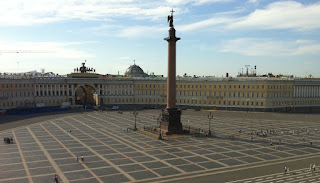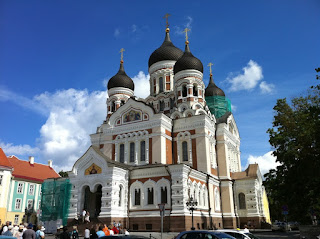Russia.
Russia is a big deal. It just is. Russian history is among the most fascinating, heartbreaking, frustrating histories from the short lifetime of modern humanity. For a few centuries it was agrarian and poor, for a few centuries it was a mess of competing feudal kingdoms, for many centuries it was an empire under Tsars, and then for less than a century it was a totalitarian, militaristic state called the USSR. I am not sure it is easy to classify Russia today. They experimented with democracy but do not really practice it, they experimented with capitalism but do not keep their markets free, and in my opinion they are experimenting with dictatorship again without quite calling it so.
There is truly no limit to what can be said about Russia. Instead, it is time to get off the ship and hop into a bus headed to The Hermitage.

Our guide Katerina, preparing us for The Hermitage. Behind her, St. Isaacs's Cathedral, the fourth largest domed church in the world.

St. Petersburg sits where the River Neva reaches the Baltic Sea. Peter The Great ordered that all the buildings face the rivers and canals and be beautiful. From a distance, they are.

The Hermitage Museum. The Winter Palace of the Tsars, in green, white and gold, was simply a palace for the Tsars. In 1764, Catherine the Great, who expanded the borders of the Russian Empire further even than Peter The Great, took a smaller building next to the Winter Palace and placed her art collection there, naming it her Hermitage, a place to be alone with her art collection like a hermit. Soon her collection outgrew this, "Little Hermitage," and she built a second building.
The art collecting of the Romanovs knew few limits. Fortunately, Nicholas I visited Munich in 1838 and was impressed by the public museums that were works of architectural art in themselves. He hired a German architect to build him such a museum, and the New Hermitage was born next to the Little Hermitage and the Old Hermitage. At this point, The Hermitages were open to the public -- the first public museums in Russia -- though it obviously depended upon your status whether or not you actually got inside.
But guess who we owe today's Hermitage collection to? The Bolsheviks. When they stormed the Winter Palace in 1917 and took control of Russia, they declared the Winter Palace and the Hermitage to be state museums. And, in keeping with their beliefs, the new Soviet State seized private art collections throughout Russia during the following decades, increasing the state's art collection threefold. Then along came World War II and Russia was forced, yes, forced, to take half of Europe away from Hitler. In the process, a lot of the art in that half of Europe ended up at the Hermitage.

My ticket to The Hermitage Museum. You know, when I think about it, maybe the 70 years when there was simply no way for a Westerner to enter this building in "Leningrad" will be an afterthought. One can hope that St. Petersburg shall remain open to the world for good.
Museums. I did not even bother saying much about the Louvre during last month's visit, because how could an educated person who can read English not know that Paris' Louvre Museum is one of the greatest museums in the world? Well, The Hermitage… let me put it this way. It is on par with the Louvre. Barbie and I both actually feel that it is more impressive, but I allow that this could be because the Louvre has always been available to us. However, the art collection at The Hermitage is simply overwhelming.
And not just a piece of Dutch impressionism here and a touch of cubism there with some Renaissance over here. Amazing pieces of art from every era of recorded history, grouped together in significant numbers, presented in a royal palace that rivals any in the world. And they allow photography in the Hermitage Museum, as long as you do not use a flash. Do you have any idea how many pictures I took?
I am not even going to try to show you a complete picture of what you see when you visit the Hermitage. Instead, I am going to show you a few favorites here and there, chosen sometimes for the art and sometimes because I particularly like the picture that I took. All I have to say is that if you care even a little about art, about what mankind has managed to create over the last few millennia, then a visit to the Hermitage has to be on your list.

Cupid, Etienne Maurice Falconet, 1757.
Still life with Drapery, Paul Cézanne, 1895.
Out the window, I spotted the Palace Square, or Dvortsovaya Pl, and the Alexander Column which commemorates Alexander I's triumph over Napoleon in 1812. You know, Napoleon and the Tsars battled so frequently, and each built an arch or a column every time that they won a battle, that you really cannot help but be disgusted by these men and their ambitions. Today may be the best time to ever be alive, and I am serious about that, because it would appear that no European emperor is ever going to try to conquer the world again.

It breaks my heart that I am not going to get into that square. Was there ever a more perfect place for a panorama shot? Why, you ask, am I not going to stand there? This gets us into what is pretty annoying about Russia. I will save it for another day. We are here for three, and there is no need to get into that on day one.
Time to stop looking out the window.

Dance, Henri Matisse, 1910.
Two Sisters (The Visit), Pablo Picasso, 1902. Considering how much Picasso has been displayed on the Waste, I thought I would mess with your heads and show you something earlier.
Okay, I am still predictable.
Musical Instruments, Pablo Picasso, 1912.
I did not get the information on the faun, but I wanted to share with you the amazing room where it rests. You know, when Baroque rooms restrain themselves to be mostly white, I quite like it.

A throne room. Take that in. Can you imagine walking through a museum and coming across a room that is itself a work of art to this degree?

The Hermitage Theater, added in the 1780's for the Imperial Family to take in a show with their closest friends.

The Loggia of Raphael, reproduced for Catherine the Great. When she visited the Vatican, she so fell in love with Raphael's Loggia that she got Papal permission to have Raphael's students recreate the Loggia for her, replacing the Papal coat-of-arms with the Romanov two-headed eagle, of course. The original was destroyed by fire, making this copy extremely important.

Kiss of Cupid and Psyche, 1797, Antonio Canova.
Portrait of an old Jew, Rembrandt Harmensz van Rijn, 1669.
I had to throw in a Rembrandt, and, well, Barbie and I both found the title of this painting too hilarious to ignore.
Black-glazed Hydria, the so-called regina vasorum, 4th Century B.C. Found off the coast of Campania, Italy. When you see a vase that is 2,400 years old, you take a picture and you show it to people.
Time for a lunch break.

Outside the Hermitage, you see this wonderful view of the Peter and Paul Fortress. Peter the Great began planning this city before the territory had been won from Sweden. As history is a series of coincidences, King Charles IV of Sweden absolutely had Peter defeated, but instead of going into Moscow to finish off Russia for good, he turned to attack Poland, which he considered a more serious threat at that time. Sweden's battles with Poland gave Peter time to modernize his army and build this fortress, and by the time the Swedes returned Peter was able to win a decisive victory.
Can you imagine a world where modern day Russia is a part of Sweden? Sweden, which never had serfdom, and whose principles of human rights have made it the most open and democratic nation on Earth today? It boggles the mind.
For lunch, we were loaded back onto the bus and taken to a genuine Russian restaurant.

Note the basement decor.
We were served chicken with some gravy and potato wedges. I liked it a lot more than anyone else in my family.
Dessert was ice cream. They offered us champagne and vodka as well, but we passed on it. We are headed back to the Hermitage, after all.

When you finish a cup of Russian coffee, this is what you see.
Our restaurant was across the street from the Church on the Spilled Blood. We are visiting this church the day after tomorrow, and I will save the sad history of this church for then.

This city of rivers and canals should rival Amsterdam and Venice, the cities that inspired it. We would need the Russian government and people to greatly change their mind-set for this to be reality, but anything is possible. There is something about St. Petersburg that is just not quite right. There is something angry and distant about this city and its people. It is a shame, and I hope it will change someday.

This monument was inspired by the Vatican. In a way, St. Petersburg was Vegas of the 18th century, building homages to the great cities of the world.
Back inside the Hermitage…

A close-up of a Roman statue in the foreground, with a first century AD colossal Jupiter in the background.
I asked myself why this Waste entry is statue heavy. The answer? Pictures of three dimensional subjects look better than pictures of two dimensional subjects.
This may be my favorite picture of the day. Clearly this Greek woman is contemplating whether or not she should turn to Barbie and ask why her husband has an iPhone in her face.

I do love artichoke. In case you wondered, the ancient Greeks did as well.
These Greek statues were in front of the Gold Room, where the imperial jewels are kept. You can imagine the kind of jewelry that the Tsars and Tsarinas collected. And it leaves little doubt why the excesses of royalty leads to revolution. By the way, in addition to watches and rings and diamonds and emeralds, the Gold Room also has the imperial collection of Greek and Roman gold artifacts. From coins to daggers, these pieces that dated to the 5th century BC (2,600 years ago) were amazing.
And with that, our eight hour day at the Hermitage ended.

Back on the bus, this photograph does not reveal the extent to which Soviet-era buildings are horribly ugly. I suppose they wanted the people to be depressed. The truth is that I cannot even speculate. One day in Russia and the only thing for certain is that I would need to have an honest conversation dozens of locals to understand what has happened here. They defeated Hitler, pretty much without our help, only to live under their own totalitarian, militaristic, and genocidal government. Yet I suspect there is pride in and loyalty to country, even when it is a horrible one. Like people who defend abusive parents.
Barbie has felt sick all day, and went to bed almost immediately. I headed down to dinner.

A tuna steak.
Pear and lillet sherbet.
Time to go back to the room and see how Barbie is. We have another long day planned in St. Petersburg tomorrow. Hopefully some rest will help.
Until tomorrow...

























































